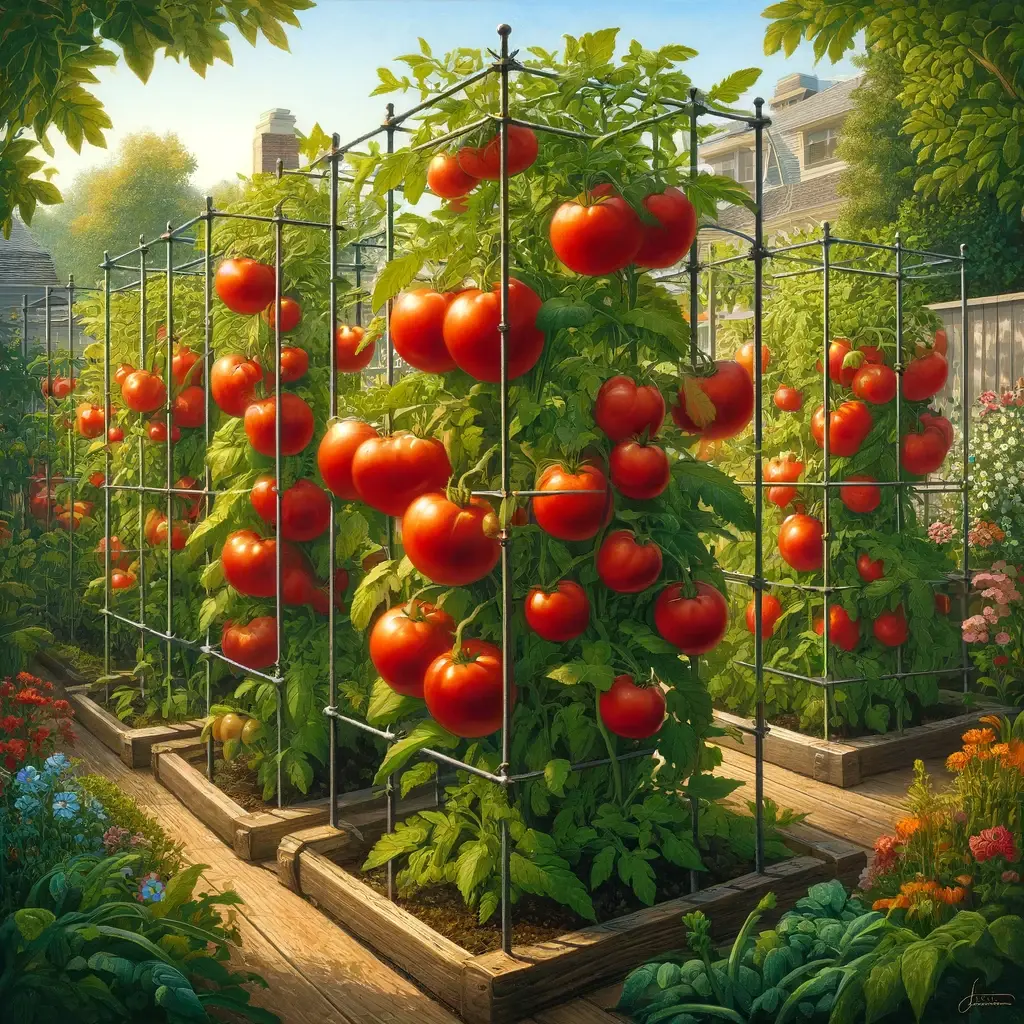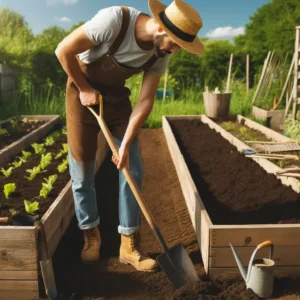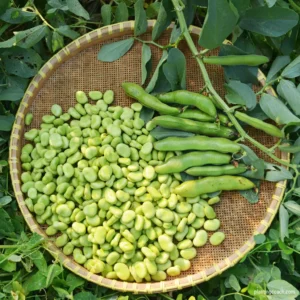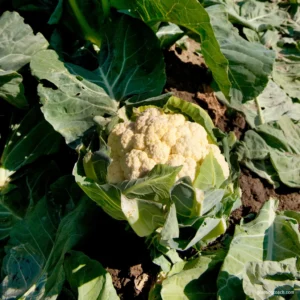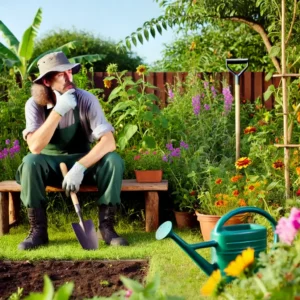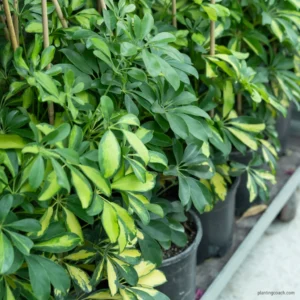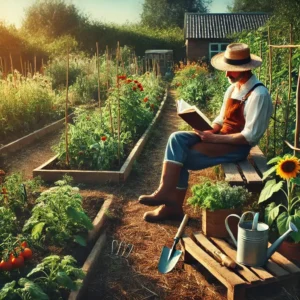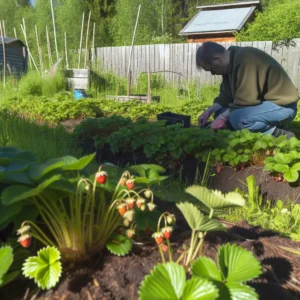Home gardening in the United States has become an appreciative activity, welcomed by millions who seek to connect with nature and improve their self-sufficiency. As lifestyles shift towards more sustainable practices, the temptation of cultivating one’s own food has grown significantly. This movement not only nurtures an appreciation for the earth’s reward but also promotes healthier eating habits and significant cost savings on grocery bills.
The question many beginner and experienced gardeners find themselves asking is: What is the most popular crop in US home gardens? Identifying this crop provides insights into cultural trends, regional preferences, and the practical considerations that shape American gardening choices today. In this article, let’s explore these aspects, diving into the reasons behind the popularity of certain crops and offering practical advice for aspiring gardeners.
Overview of Home Gardening in the U.S.
Home gardening has constructed itself into the fabric of American culture, transitioning from an effective necessity to a widespread hobby that ensures health, sustainability, and pleasure. Historically, the practice increased during times of economic hardship or food shortage, notably during the World Wars when citizens cultivated ‘victory gardens’ to support the war effort and feed their families. Today, the motivations behind home gardening have shifted towards improving quality of life and dietary habits and ensuring food security without relying entirely on commercial supply chains. Gardening offers many health benefits, including physical exercise and stress reduction. It also advances a connection to the earth and the seasons, which can be incredibly remedial in urban settings where green spaces are limited.

Economically, it can significantly decrease household expenditures on produce, while environmentally, it reduces the carbon footprint associated with large-scale agricultural production, packaging, and long-distance transportation of food products. Additionally, the trend towards organic gardening has helped revive interest in different varieties and biodiversity, further enriching America’s garden landscape. By engaging in gardening, individuals not only contribute to their health and well-being but also play a part in a more significant movement towards environmental supervision and sustainability.
Factors Influencing Crop Popularity
Several key factors determine the popularity of specific crops in home gardens across the United States. The primary factor is the regional climate, which dominates what plants can grow well in certain areas. For instance, the warm, sunny climates of states like California and Florida are ideal for growing citrus fruits and avocados, while cooler, more temperate regions might see better success with root vegetables and hardy plants. Soil type is another crucial consideration; different plants require different soil conditions to flourish.
For example, sandy soils, which drain quickly, are great for plants that dislike wet roots, whereas clay soils, which retain moisture, might be better suited for crops that require more water. The ease of growing certain crops also plays a significant role in their popularity. Many gardeners opt for plants that are less vulnerable to diseases and pests and that do not require excessive maintenance.
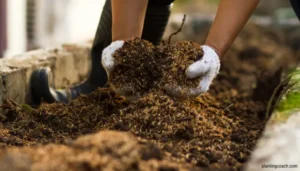
The level of care required can influence a gardener’s choice, especially if they are beginners or have limited time to dedicate to gardening. Furthermore, cultural and personal preferences often drive crop choices, as individuals might grow plants that they particularly enjoy eating or that hold sentimental value, such as those used in family recipes passed down through generations. Understanding these factors can help gardeners choose the most appropriate and rewarding crops for their specific conditions, boosting their gardening experience and success.
The Most Popular Crops in US Home Gardens
Among the vast formation of vegetables and fruits cultivated in American home gardens, tomatoes stand out as the most popular choice, frequently topping gardening polls and surveys. This popularity is due to several factors, including their ease of growth and the substantial difference in taste and texture compared to store-bought varieties. Tomatoes are incredibly versatile in the kitchen, featured in everything from fresh salads to cooked dishes, and can be preserved through canning or drying. Their adaptability to different growing conditions and methods, from in-ground gardening to container gardening, makes them accessible to a wide range of gardeners, from those with huge backyard plots to urban balcony gardeners.

Additionally, tomatoes are relatively easy for beginners to start with, offering depth in variety and technique for more experienced gardeners. The tactile pleasure of harvesting ripe tomatoes, coupled with their health benefits, such as high levels of vitamins A and C, and lycopene, a powerful antioxidant that contributes to their status as a favorite. Moreover, the community and cultural aspects of growing tomatoes, where gardeners often share seeds, tips, and harvests, also play a role in their popularity, creating a sense of community and shared experience among enthusiasts.
Regional Variations in Crop Choices
The diversity of the U.S. climate means that the most suitable and popular crops can vary significantly from one region to another. In the dry and hot climates of the Southwest, gardeners tend to favor drought-resistant plants such as chili peppers, which require less water and can tolerate intense heat. In contrast, the humid and often rainy Southeast supports the growth of moisture-loving plants like okra and sweet potatoes, which flourish in warm and wet conditions.
The Midwest, known for its fertile soil and dramatic seasonal changes, supports a wide range of crops, from soybeans and corn in rural areas to tomatoes and squash in more personal garden plots. In the cooler Northeast, short growing seasons and cooler temperatures make crops like cabbage, peas, and root vegetables more viable options.

These regional preferences are not only a reflection of the environmental conditions but also of the cultural and dietary traditions of each area. For instance, southwestern cuisines often feature chili peppers, while traditional Southern cooking frequently uses okra and sweet potatoes. Understanding these regional variations can guide gardeners in selecting crops that will grow well in their local environment, align with their culinary preferences, and meet their dietary needs, making the gardening experience both practical and enjoyable.
Nutritional Benefits of Tomatoes- the Most Popular Crop
Tomatoes not only reign as a versatile culinary favorite but also shine as a powerhouse of nutritional benefits, which boost their appeal to health-conscious gardeners. Being rich in vitamins C and K, they offer essential nutrients that support immune health and bone strength. Additionally, tomatoes provide a good source of potassium, which is vital for blood pressure control and cardiovascular health, and folate, which is crucial for cell function and tissue growth.
One of the outstanding components in tomatoes is lycopene, an antioxidant with a potential role in reducing the risk of chronic diseases such as heart disease and various forms of cancer. Lycopene is also known for its ability to protect skin from sun damage, making tomatoes a popular choice for those interested in natural health remedies. The bioavailability of lycopene increases when tomatoes are cooked, which makes tomato sauces and cooked dishes not only delicious but also particularly beneficial.
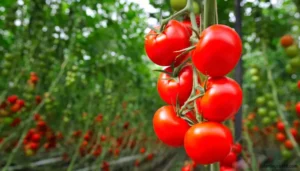
Furthermore, tomatoes are low in calories, making them an ideal food for managing weight. Regular consumption of tomatoes can contribute to a well-rounded diet, particularly beneficial for individuals looking to improve their intake of vitamins and minerals through natural food sources rather than supplements. By growing tomatoes at home, gardeners can ensure they are consuming the freshest produce, free of pesticides and preservatives, thereby reaping the maximum health benefits the fruit has to offer.
Growing Tips for Tomatoes
For those eager to cultivate tomatoes to achieve a bountiful harvest requires attachment to some proven and true gardening practices. Tomatoes demand a sunny spot, with at least six to eight hours of direct sunlight daily, which is crucial for their growth and fruit development. The ideal soil for tomatoes is well-draining, rich in organic matter, and maintains a neutral pH between 6.0 and 7.0. Before planting, mixing the soil with compost or a balanced fertilizer can provide the necessary nutrients for strong growth.
Watering is critical; tomatoes need a consistent supply of moisture, especially as fruits are developing, but it’s important to water at the base to avoid wetting the leaves, which can lead to fungal diseases. Mulching around the plants can help retain soil moisture and regulate soil temperature, reducing the stress on the plants during hot weather.
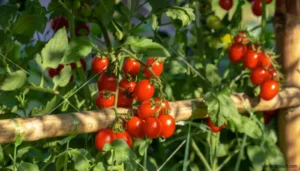
Staking or using cages for support is recommended to keep the growing vines upright and protect the fruits from touching the ground, where they are vulnerable to pests and rot. Trimming excess leaves can improve air circulation and sun exposure to the fruits, which helps in preventing diseases and promotes even ripening. Regions with shorter growing seasons can start seeding indoors about 6 to 8 weeks before the last frost date which may result in extending the growing period. These practices, when consistently applied, can lead to successful tomato cultivation, providing gardeners with a plentiful supply of fresh tomatoes throughout the growing season.
Alternatives to Tomatoes
While tomatoes are a leading choice in many gardens, exploring alternatives can diversify your garden and extend your growing season. Bell peppers and cucumbers are excellent examples of crops that are also popular among home gardeners for similar reasons as tomatoes—they are relatively easy to grow and provide substantial produce. Bell peppers, in particular, grow well in conditions similar to those of tomatoes, preferring warm soil and plenty of sun. They are less prone to some of the common diseases that affect tomatoes, making them a good crop to rotate with tomatoes to maintain soil health and prevent disease cycles.
Cucumbers require similar care but are particularly prolific, often producing plentiful yields from just a few plants. They are excellent for trellising, which can save space and reduce pest issues.


Both crops offer nutritional benefits: bell peppers are high in vitamins A and C, while cucumbers are hydrating and good for skin health due to their high water content and the presence of silica. Including these crops in your garden not only adds variety to your diet but also increases the visual appeal of your garden space with their different shapes and colors. Additionally, experimenting with other crops like zucchini, squash, and various herbs can introduce new flavors and textures to your meals, making each gardening season both a culinary and a learning experience.
Future Trends in Home Gardening
Looking forward, home gardening is set to evolve with advancements in technology and shifts in societal habits toward food production and consumption. Technological innovations, such as automated irrigation systems, app-based monitoring of plant health, and precision farming tools, are making gardening more accessible and efficient for people of all skill levels. As urbanization continues to increase, urban gardening techniques, including vertical gardens and hydroponics, are expected to rise in popularity, offering solutions for growing food in limited spaces. Additionally, the impact of climate change is prompting gardeners to adapt by selecting crops that are more sustainable to altered weather patterns and experimenting with new varieties that may have been previously unsuitable for their regions.

The growing interest in sustainability and organic living is likely to drive the popularity of home gardening further as more individuals seek to reduce their environmental footprint and gain more control over what they consume. These trends not only forecast a potential future for home gardening but also signify a shift towards more environmentally conscious and health-focused living practices, underpinning the role of gardening in shaping a sustainable future.
Summary
In a nutshell, understanding the popularity of tomatoes in U.S. home gardens reveals much about American gardening practices, regional preferences, and the practical benefits of growing one’s own food. The exploration of alternative crops and the anticipation of future trends further enrich this understanding, offering a roadmap for aspiring gardeners and seasoned green thumbs alike. By adapting to these insights, gardeners can improve their practice, contributing not only to their households but also to their community and the environment.
FAQ
Q1: What are the easiest crops to grow for beginners?
Beginners might find lettuce, radishes, and green beans particularly easy and rewarding due to their low maintenance and quick harvest times.
Q2: How much space is needed to grow the most popular crop?
Tomatoes can be grown in as little space as a small container on a balcony or a large garden bed, making them versatile for various living situations.
Q3: What are the most common challenges in growing tomatoes and how can they be overcome?
Common challenges include pests, diseases, and watering issues. These can be managed through proper plant care, use of natural pesticides, and consistent watering practices.
Q4: Are there organic options for pest and disease management for tomatoes?
Yes, options such as neem oil, insecticidal soaps, and creating biodiversity with companion planting can effectively manage pests and diseases organically.
Q5: How can gardeners extend the growing season of tomatoes?
Using techniques like mulching, using row covers, and choosing early maturing varieties can help extend the growing season.
